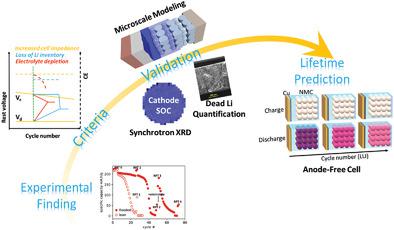当前位置:
X-MOL 学术
›
Small Methods
›
论文详情
Our official English website, www.x-mol.net, welcomes your
feedback! (Note: you will need to create a separate account there.)
Fast Diagnosis of Failure Mechanisms and Lifetime Prediction of Li Metal Batteries
Small Methods ( IF 10.7 ) Pub Date : 2020-11-03 , DOI: 10.1002/smtd.202000807 Ningshengjie Gao 1 , Alexander W Abboud 1 , Gerard S Mattei 2, 3 , Zhuo Li 2, 3 , Adam A Corrao 2 , Chengcheng Fang 4 , Boryann Liaw 1 , Ying Shirley Meng 4 , Peter G Khalifah 2, 3 , Eric J Dufek 1 , Bin Li 1
Small Methods ( IF 10.7 ) Pub Date : 2020-11-03 , DOI: 10.1002/smtd.202000807 Ningshengjie Gao 1 , Alexander W Abboud 1 , Gerard S Mattei 2, 3 , Zhuo Li 2, 3 , Adam A Corrao 2 , Chengcheng Fang 4 , Boryann Liaw 1 , Ying Shirley Meng 4 , Peter G Khalifah 2, 3 , Eric J Dufek 1 , Bin Li 1
Affiliation

|
Lithium (Li) metal serving as an anode has the potential to double or triple stored energies in rechargeable Li batteries. However, they typically have short cycling lifetimes due to parasitic reactions between the Li metal and electrolyte. It is critically required to develop early fault‐detection methods for different failure mechanisms and quick lifetime‐prediction methods to ensure rapid development. Prior efforts to determine the dominant failure mechanisms have typically required destructive cell disassembly. In this study, non‐destructive diagnostic method based on rest voltages and coulombic efficiency are used to easily distinguish the different failure mechanisms—from loss of Li inventory, electrolyte depletion, and increased cell impedance—which are deeply understood and well validated by experiments and modeling. Using this new diagnostic method, the maximum lifetime of a Li metal cell can be quickly predicted from tests of corresponding anode‐free cells, which is important for the screenings of electrolytes, anode stabilization, optimization of operating conditions, and rational battery design.
中文翻译:

锂金属电池失效机理的快速诊断和寿命预测
用作阳极的锂 (Li) 金属有可能将可充电锂电池中的存储能量增加一倍或三倍。然而,由于锂金属和电解质之间的寄生反应,它们通常具有较短的循环寿命。迫切需要开发针对不同故障机制的早期故障检测方法和快速寿命预测方法,以确保快速发展。先前确定主要故障机制的努力通常需要破坏性的电池拆卸。在这项研究中,基于静止电压和库仑效率的无损诊断方法被用来轻松区分不同的失效机制——从锂库存的损失、电解质耗尽和电池阻抗增加——这些都得到了深刻的理解,并通过实验和验证得到了很好的验证。造型。
更新日期:2020-11-03
中文翻译:

锂金属电池失效机理的快速诊断和寿命预测
用作阳极的锂 (Li) 金属有可能将可充电锂电池中的存储能量增加一倍或三倍。然而,由于锂金属和电解质之间的寄生反应,它们通常具有较短的循环寿命。迫切需要开发针对不同故障机制的早期故障检测方法和快速寿命预测方法,以确保快速发展。先前确定主要故障机制的努力通常需要破坏性的电池拆卸。在这项研究中,基于静止电压和库仑效率的无损诊断方法被用来轻松区分不同的失效机制——从锂库存的损失、电解质耗尽和电池阻抗增加——这些都得到了深刻的理解,并通过实验和验证得到了很好的验证。造型。











































 京公网安备 11010802027423号
京公网安备 11010802027423号